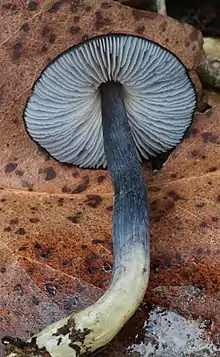Entoloma moongum
Entoloma moongum is a South Australian species of fungus in the large agaric genus Entoloma (subgenus Leptonia). It was described as new to science by mycologist Cheryl Grgurinovic; the original holotype collections were made from Belair National Park in the 1930s by John Burton Cleland, who erroneously referred the fungus to Leptonia lampropus (now Entoloma lampropus).[1]
| Entoloma moongum | |
|---|---|
 | |
| Scientific classification | |
| Domain: | Eukaryota |
| Kingdom: | Fungi |
| Division: | Basidiomycota |
| Class: | Agaricomycetes |
| Order: | Agaricales |
| Family: | Entolomataceae |
| Genus: | Entoloma |
| Species: | E. moongum |
| Binomial name | |
| Entoloma moongum Grgur. (1997) | |
The fruitbody has a dark brown to purplish brown cap up to 19 mm (0.75 in) in diameter with a surface that is finely fibrillose, and a cap cuticle consisting of narrow hyphae. The spores measure 9.6–13.6 by 5.6–8.4 µm and have 5–6 blunt angles. Basidia (spore-bearing cells) are club-shaped, measuring 34.4–48.8 by 9.6–12.8 µm, with sterigmata up to 6 µm long. The specific epithet derives from the Aboriginal word moonga, meaning "dark".[1]
See also
References
- Grgurinovic CA. (1997). Larger Fungi of South Australia. Adelaide: Botanical Gardens of Adelaide and State Herbarium. pp. 377–8. ISBN 978-0-7308-0737-7.